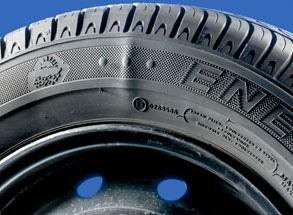The condition of your tyres has a huge impact on your vehicle’s performance on the road. Tyres control your braking distances, gripping capabilities and keep you safe in wet conditions so it is important that you look after them properly and know when it is time to replace them.
Over time, tyres will need replacing due to everyday wear and tear. Think you may need to replace your tyres? These are the signs to look out for:
Tyres are designed to grip th e surface of the road, resist aquaplaning and ensure that you brake safely. As your tread depth reduces, however, so will your tyres' capabilities.
e surface of the road, resist aquaplaning and ensure that you brake safely. As your tread depth reduces, however, so will your tyres' capabilities.
Once your tyre tread depth is lower than 3mm your tyres’ capabilities will be significantly reduced and any lower than 1.6mm is illegal. So you must have you tyres replaced when the tread falls between these depths.
You can roughly check your tyre tread depth at home using a twenty pence piece, as shown in our guide. Tyres also have tread wear indicator to show when your tyres need replacing, like on this Michelin tyre.

Large cracks in the sidewall of your tyre can be dangerous. If you notice any, you should replace your tyres as soon as possible. There could be damage to the internal structure of the tyre, which may mean it is close to a blow-out.
In addition, little cracks all over the tyre may mean that the rubber is breaking down and could be susceptible to falling apart. This could also be highly dangerous if ignored so you must have this looked over by a specialist or replace your tyres as soon as possible.

Lumps, bulges and bumps on the surface of the tyre are all signs that the structural integrity of the tyre has been compromised.
This weakening of the internal structure of the tyre means the tyre may no longer able to support the load of your vehicle, and if put under continued load could lead to a dangerous blow-out.
This type of tyre damage, unfortunately, cannot be repaired.
 Most punctures can be repaired as long as the puncture is within the central ¾ of the tyres tread, and no additional structural damaged has been caused.
Most punctures can be repaired as long as the puncture is within the central ¾ of the tyres tread, and no additional structural damaged has been caused.
Even if a tyre specialist says your punctured tyre is repairable, it is worth considering your tyre's condition. If it is fairly worn, it might be more economical to simply replace it a little early.
For further advice on tyre safety or if you would like to have your tyres checked over by a specialist, contact your local Dexel Tyre and Auto Centre branch.
Alternatively, you can purchase new tyres easily online. Simply search for your tyre size and select the tyres of your choice. You can then either purchase online, or reserve and collect, and arrange a fitting at your local branch at a time to suit you.